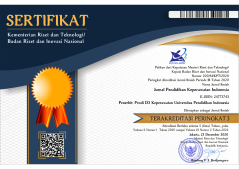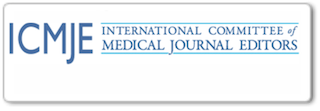The Effect of Disaster Education on The Ability of Adolescents to Recognize COVID-19 Prevention
Abstract
Disaster education to reduce disaster risk in adolescence is essential. An infectious disease that is currently spreading is covid-19. Emerging epidemiological reports of covid-19 in children show that, while they are less likely to become infected and to have the severe disease than adults, children are vulnerable to the coronavirus pandemic. This research aimed to find out the effect of disaster education on children's ability to recognize Covid-19 prevention. This research design is quasi-experimental with a one-group pretest-posttest design approach. Disaster education intervention Covid-19 covers disaster aspects (prevention, detection, and response phases). The research instrument uses a questionnaire on students' ability to recognize covid-19 prevention. Data analysis using the Wilcoxon test showed p-value of 0.000. There is an effect of providing disaster education on children's ability to recognize covid-19 prevention. The early introduction of disaster or disease outbreaks and their prevention are the concrete means that need to be given to the younger generation to increase the children's knowledge and shape alertness behavior in dealing with the disaster or disease outbreaks.
Keywords
References
Eastin, C., & Eastin, T. (2020). Epidemiological characteristics of 2143 pediatric patients with 2019 coronavirus disease in China: Dong Y, Mo X, Hu Y, et al. Pediatrics. 2020; DOI: 10.1542/peds.2020-0702. The Journal of Emergency Medicine, 58(4), 712–713.
Liliani, E. (2010). Pemanfaatan Sastra Anak sebagai Media Mitigasi Bencana. Jurnal Penelitian Humaniora, 15(1), 39-58.
Nugraha, A., Ernawati, E., Utama, T. A., & Rinjani, S. (2020). Smoking and Comorbidities in Covid-19: A Systematic Review. Unnes Journal of Public Health, 9(2), 117–125.
Ruskandi, J. H. (2021). Kecemasan Remaja pada Masa Pandemi Covid-19. Jurnal Penelitian Perawat Profesional, 3(3), 483–492.
Salasa, S., Murni, T. W., & Emaliyawati, E. (2017). Pemberdayaan pada Kelompok Remaja melalui Pendekatan Contingency Planning dalam Meningkatkan Kesiapsiagaan terhadap Ancaman Kematian Akibat Bencana. Jurnal Pendidikan Keperawatan Indonesia, 3(2), 154–166.
Sari, S. A., Milfayetty, S., & Dirhamsyah, M. (2014). Pengaruh Pengintegrasian Materi Kebencanaan Ke Dalam Kurikulumterhadap Kesiapsiagaan Bencana Gempa Bumi Dan Tsunami Pada Siswa Sekolah Dasar Dan Menengah Di Banda Aceh. Jurnal Ilmu Kebencanaan: Program Pascasarjana Unsyiah, 1(1), 1-10.
Tahmidaten, L., & Krismanto, W. (2019). Implementasi pendidikan kebencanaan di Indonesia (sebuah studi pustaka tentang problematika dan solusinya). Lectura: Jurnal Pendidikan, 10(2), 136–154.
Wasliyah, S. (2018). Komik Bencana Meningkatkan Sikap Kesiapsiapan Bencana pada Anak Sekolah Dasar Negeri Bulakan Kecamatan Gunung Kencana Banten Selatan Tahun 2017. JPP (Jurnal Kesehatan Poltekkes Palembang), 13(1), 28–36.
Widjanarko, M., & Minnafiah, U. (2018). Pengaruh pendidikan bencana pada perilaku kesiapsiagaan siswa. Jurnal Ecopsy, 5(1), 1–7.
DOI: https://doi.org/10.17509/jpki.v7i2.35705
Refbacks
- There are currently no refbacks.
Jurnal Pendidikan Keperawatan Indonesia(JPKI) published by Indonesia University of Education. JPKI is licensed under a Creative Commons Attribution-ShareAlike 4.0 International License.
Office :
Nursing Department. FPOK UPI.
229, Dr. Setiabudhi Street. Bandung 40154
West Java , Indonesia
E-mail : jpki@upi.edu

_.png)
_.png)
_.png)











